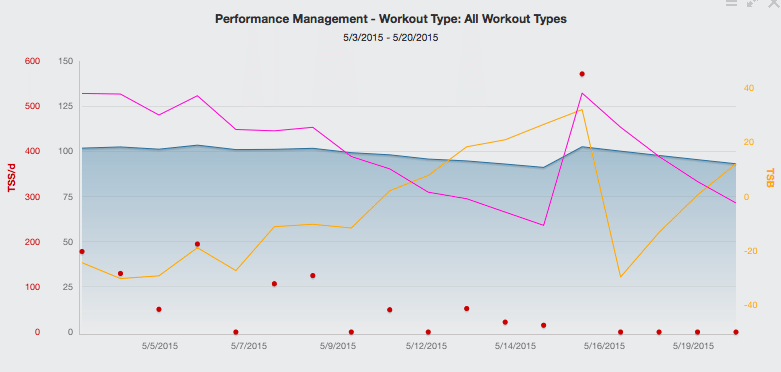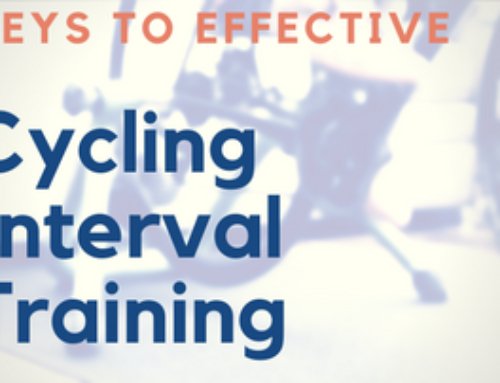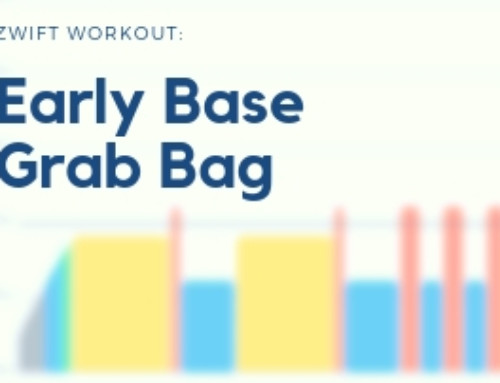Peaking and tapering are essential to a high quality performance in a race or event. They are often overlooked by your average cyclist and may be the missing piece in your successful training program. Without a well thought out, well executed peak, your body may be too tired to perform or too flat (from lack of stimulus) to successfully execute the necessary work to succeed in your race or event. If you ignore the importance of a proper taper, you'll find yourself struggling to build further fitness or worse, dip a toe into the frigid waters of overtraining. In either case, you'll find yourself disappointed and struggling to piece together what went wrong.
In this episode of the Tailwind Coaching Podcast, you'll learn what peaking and tapering are, why they are an integral part of any training program and how to apply the concepts of successful peaking and tapering to your own training program.
Click through for the show notes and remember that the sponsor for this episode of the Tailwind Coaching Podcast is Stages Cycling. Check out their power meters and help support the show, and don't forget to rate the podcast on iTunes! You can also check out my new resources page and get a head start on reading some of my most popular articles!
 What is peaking and tapering?
What is peaking and tapering?
The goal of peaking is to sharpen your form. I talked about building fitness in my Efficient Base Building and Efficient Build Training podcasts, now you need to apply that fitness to an event or goal situation. By definition, form is a measure of how fresh your body is compared to your overall fitness. Note that you require fitness to have form, not just freshness. You can't have form if you don't have any fitness to back it up, so forget the idea of jumping off the couch and competing (obviously.)
Form can be numerically expressed as Training Stress Balance, or TSB, which is a ratio of CTL to ATL. These are measures of freshness, fitness and fatigue, respectively. Check out my previous post about Quantifying Training Stress Score and Fatigue for more detailed information about CTL, ATL, and TSB. In general terms, the higher the TSB the fresher the body is and the more “form” is carried into the event you're targeting.
The key to a great peak: sharpen, but don't exhaust!
Peaking is designed to sharpen form and manage fitness loss while not exhausting your body. This is accomplished by building in intervals that closely mimic event conditions. In fact, entire workouts (such as a single day on the trainer or a single outdoor ride) should be designed to be as close to race or event type as possible. For example, if you're racing a crit, workouts should involve lots of Zone 6 and Zone 7, short duration, high intensity work.
During a peak period, training volume needs to decrease significantly, while intensity needs to increase. The net effect of this is to create a situation where the body is able to maintain fitness while recovering and reducing overall fatigue from a hard training block. From a numerical standpoint, the goal is to maintain CTL while allowing ATL to drop. This numerical difference results in the positive TSB talked about earlier. The positive TSB indicates the body is recovering/recovered from hard efforts compared to a late build block where the body is constantly accumulating fatigue.
To improve the effectiveness of your peaking and tapering you need to prioritize building workouts that mimic your event, but more importantly you need to recover efficiently from those workouts. You can read more about recovery tricks in my Recover Like A Pro podcast, and use those tips to sharpen your peak even further. You need to be especially careful during your peak to recover appropriately: overtraining during this period can destroy your peak very quickly.
If you're building your own training program, keep the following points in mind:
- Cut your training volume by about 50% from the last block of your build program (maybe more if your build volume is very high.)
- You can base a peak week on a rest week or FTP testing week, but you'll need to raise the intensity compared to a rest of FTP test week.
- The first half of a peak week should be spend as short duration, high intensity work.
- The second half of the peak week should be very short duration, very high intensity work.
- Be prepared to evaluate your past performances to determine the TSB that gives you the biggest potential for a peak performance. Aim for that TSB number.
If you're struggling to build an appropriate peaking and tapering program, remember that I've got plenty of options available that lay it all out for you.
Tapering to recover and rebuild
Tapering is the key way to let your body wind down and prep your body to re-build and re-peak later in the season. Because a permanent plateau of “peaked” fitness is impossible to maintain, and consistent improvement is also impossible to attain, your body needs periods of down time and recovery prior to returning to peak form. So if you train hard and hit a peak, asking your body to again train hard and peak higher without any recovery is asking for it to end up overtrained. To put it plainly, your body needs rest if it wants to reach higher fitness levels
The other problem with the body is that it simply can't maintain a peak for long. The maximum peak capacity is about 3 weeks at best, after which performance starts to decline. Trying to maintain a very long peak can also be detrimental to your overall season goals but burning you out quickly. A proper taper will allow your body to rest, recover and repair following a long training block. This preps you for a further building, peaking and tapering cycle later in the season by balancing your body out again and re-shuffling your fitness. Keep in mind that a taper typically occurs after your hardest training block, generally right after your “A” level event.
Now, when we talk about “re-shuffling” your fitness, we're talking about letting some fitness go in favor of recovery and stress compensation. Since the body can't continue to grow indefinitely, and fitness potential is genetically capped, it takes time for the body to adapt to training stress. After a hard build/peak training block, there's a lot of training stress that needs absorbing, and tapering is the perfect way to start that. The one thing that scares a lot of people about tapering is the potential that they may “lose some fitness.”
 Tapering isn't really about “losing” fitness, per se. Typical fitness builds over the length of a season generally look like stair steps or a saw-tooth type profile. There are peaks of fitness followed by valleys which indicate time where fitness decreases a bit but freshness and recovery takes place. These dips in fitness are generally followed by larger peaks, higher overall dips, etc etc. These kinds of patterns are seen within the weekly training cycle, the monthly training cycle and even among the blocked, 3 or 4 month mesocyles as well as with the yearly macrocycle.
Tapering isn't really about “losing” fitness, per se. Typical fitness builds over the length of a season generally look like stair steps or a saw-tooth type profile. There are peaks of fitness followed by valleys which indicate time where fitness decreases a bit but freshness and recovery takes place. These dips in fitness are generally followed by larger peaks, higher overall dips, etc etc. These kinds of patterns are seen within the weekly training cycle, the monthly training cycle and even among the blocked, 3 or 4 month mesocyles as well as with the yearly macrocycle.
During a true taper, you're not “losing” fitness, but “re-shuffling” it. You're letting that high intensity fitness, the Zone 6 and 7 fitness, drop off a bit in favor of adaptations that favor Zone 4 and 5 level fitness. Remember that you don't need to PANIC when you see your CTL drop during the taper period: your body is simply absorbing previous training stress and redistributing physiological resources to help adapt to the stress you've put it under. Yes, your FTP may drop a little bit, but during your next rebuild block, you'll be starting from a larger fitness foundation, so rebuilding top fitness/form should be very easy.
In terms of training plan advice to remember, consider these points to make your taper more effective:
- Tapering typically last about 2-4 weeks and is usually followed by a resumption of training at a base or build level depending on how far out your next goal is.
- You need to ensure your season is planned out appropriately, with plenty of space between your “A” level goals to allow for taper down and build back up. You can check out my SMART Goal Setting Podcast for more info about planning your season out appropriately.
- Your taper period should be filled with low volume, low intensity work that puts minimal stress on the body (typically very aerobic stress.)
If you're having trouble piecing together your peaking and tapering strategy, you can check out my online training plans which will spell it out for you.
So now that you have the info about planning your peaking and tapering properly, what's your excuse for not hitting your goals this season?
If you enjoyed this episode, click through to the Tailwind Coaching Podcast on iTunes and rate it 5 stars. A positive review helps the podcast move up the ratings, reach more listeners, and help more people get stronger, faster and fitter. Don't forget to post any questions to the Tailwind Coaching Facebook page, on the Tailwind Coaching forums, contact me via email or leave a comment below. Don't forget to support our sponsors and help to keep this podcast free, help me to get this information to more people and help grow the cycling community.
Want to get MORE tips and tricks on how to increase the return on your training investment? Subscribe to the Tailwind Coaching Newsletter to get my best coaching tips delivered to your inbox, along with a free bonus training plan.
If you're looking for a complete training solution, you can pick up your training plans by checking out my modular training plans in my online store. Summer goals will be here before you know it, so you'll need to start building fitness and thinking about climbing, sprinting or preparing for a century ride. Let me help you out by providing your training path to glory!
[wdsm_ad id=”5402″ class=” aligncenter” ]





